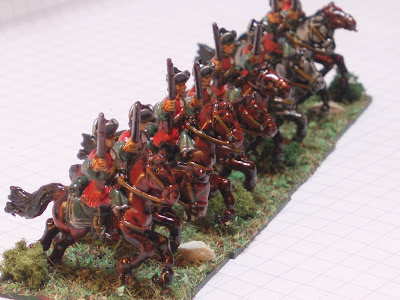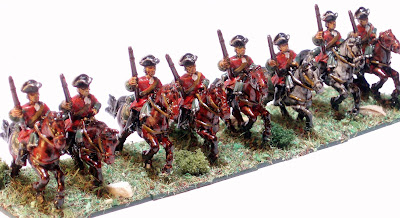 So sprayed and based, here they are at last...
So sprayed and based, here they are at last...As was usual in this era the regiment was named after their Colonel who was a gentlemen called Hugh Wyndham; he took command of the regiment on the 31st January 1692.
The regiment was descended originally from the Ninth Regiment of Horse, who had been raised in 1685 in response to the Duke of Monmouth's rebellion during the first year of the reign of King James II.
On it's founding the colonelcy of the Ninth Horse had originally been given to Richard, 2nd Viscount Lumley of Waterford. In accordance with tradition of the time, the regiment became known as Lord Lumley's Horse but shortly thereafter, Lumley petitioned the Queen Dowager to permit naming the regiment as "The Queen Dowager's Horse", which request was granted.
In 1691, during King William's Irish Campaign, the regiment distinguished itself, as a result of which it was posted to London and was re-named "The King's Carabiniers".

This regiment, more than many of the others I've researched, seems to have changed names quite a lot:
1685.07.31 The Queen Dowager's Regiment of Horse
ranked as 9th Horse, named for Queen Catherine, widow of Charles II; also known until 1751 by the names of colonels
1690 ranked as 8th Horse
1692 The King's Regiment of Carabiniers (re-named for William III)
1694 ranked as 7th Horse
1740 His Majesty's 1st Regiment of Carabiniers
1746.12.25 ranked as 3rd Horse on Irish Establishment
1751.07.01 3rd Regiment of Horse
1756 3rd Regiment of Horse (Carabiniers)
1788.04.01 6th Regiment of Dragoon Guards (transferred from Irish to British Establishment)

The regiment served with distinction throughout the War of the Spanish Succession and was present at all of the major battles of the period. During the assault on the Schellenberg they were in Woods Brigade (Ten squadrons of English horse comprising in addition Wood's [2 squadrons],Schomberg [2 squadrons], Cadogen [One squadron] & Lumley's [Three squadrons]).
At Blenheim they were still 2 squadrons strong, and in Brigadier General Palmes' Brigade along with Wood's (reduced to one Squadron) & Schomberg's (still 2 squadrons).
Wyndham was the second son of Colonel Francis Wyndham (a noted ECW commander) & Anne Gerard, and was born in 1649. I've not managed to find out much about him but I know he was considered an experienced officer of cavalry, who had distinguished himself at the Boyne, and at the siege of Limerick. He died (a bachelor) in 1706, at Valencia in Spain - there's a bit of a tantalising lead to follow up as I suspect he may have been killed on active service as part of the campaign in Spain**.
When he died, the Colonelcy was passed to Brigadier Francis Palmes (1st October 1706) - the same as who had commanded the brigade they were in at Blenheim. He had been wounded at Blenheim, but made a Lieutenant-General in 1709. In 1707 he was elected MP for West Loo; in 1708 he was sent as Envoy Extraoridinary to the Duke of Savoy, and in 1710 to Vienna. By all the accounts I've read, he was highly regarded by Marlborough...
Figures are Essex 15mm, purely a personal perception but I do get irritated with the tiny bases on Essex figures - it makes it very difficult to temporarily base them for painting. The figures are also a mixed bag - some are very nice, and some are excellent - unfortunately you don't get to choose which one's you have! Figures are also two part and I found the men didn't always fit as well as they should to the horses...
** During the War of the Spanish Succession, Valencia sided with Charles of Austria. On 24 January 1706, Charles Mordaunt, 3rd Earl of Peterborough, 1st Earl of Monmouth, led a handful of English cavalrymen into the city after riding south from Barcelona, capturing the nearby fortress at Sagunto, and bluffing the Spanish Bourbon army into withdrawal. The English held the city for 16 months and defeated several attempts to expel them. English soldiers advanced as far as Requena on the road to Madrid.
Steve,
ReplyDeleteThey look really great - what static grass do you use on the bases?
Ian
Very nice and a well presented article.
ReplyDeleteHave you ever though of compiling all these into a booklet for publication - I know the information is out there already on the net but to have it all in one little handy booklet? Hmmmm.
Thanks for the kind words, gents - just for once I was happy with the way these guys looked in the pictures - I especially liked the top one... :o))
ReplyDeleteRe. the static grass - sorry Stryker, I honestly can't remember... I bought a pack of it at some show or another a couple of years back, plain vanilla/unbranded as far as I remember, and just emptied it into my "flock pot" with all the other stuff that was already in there.... the pot contains a selection of all sorts of the joe-basic woodchip flock, and adding the static grass was a bit of a stroke of genius as the grass seems to pick up static either from the flock, or the fact that it's in a plastic tub... either way, it looks quite effective and I don't have to do any of that "blowing it" and "turning it upside down" stuff... I just give the pot a shake before dipping the bases in.
Grimsby - what a thought.... :o)) I can tell you that all the unit histories, and the units, are all present on my WSS Project Page. The research I do is only from the "interweb" (from links on the project page & Google), any books I have, and occasionally the *very* helpful people on the "Early Linear Warfare" Yahoo group (Dan Schorr is a bit of a gold mine)...
Steve,
ReplyDeleteI also really like these unit/commander histories (as I've mentioned before). They make for wonderful glimpses into another time.
And I agree that these lads look very good.
Thank you again.
-- Jeff
Steve,
ReplyDeleteGreat painting, basing, and varnishing there! Thanks for taking us through the painting process.
Best Regards,
Stokes